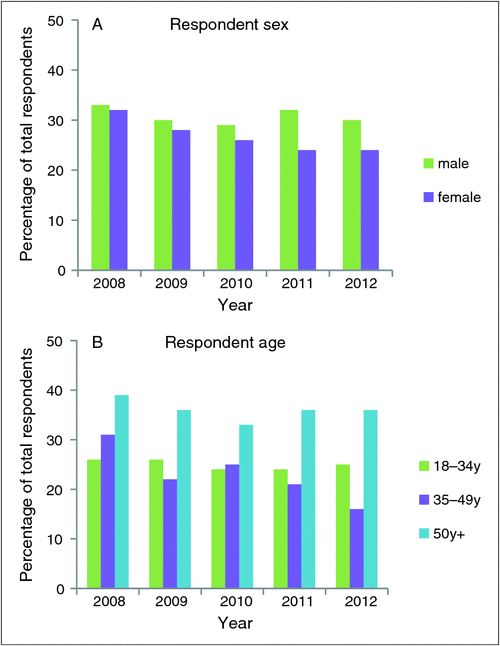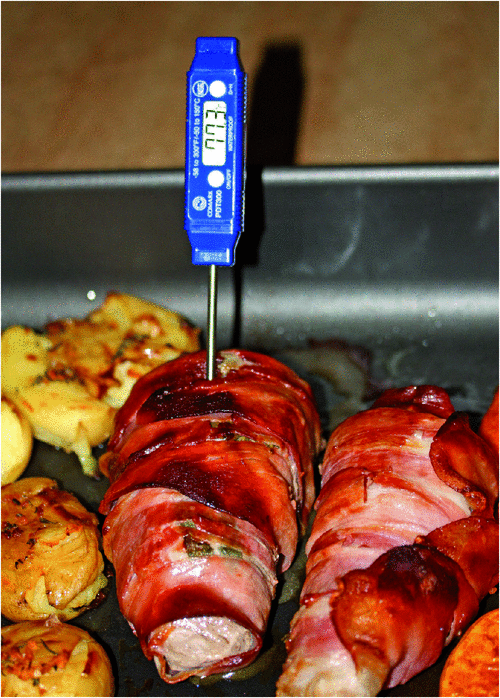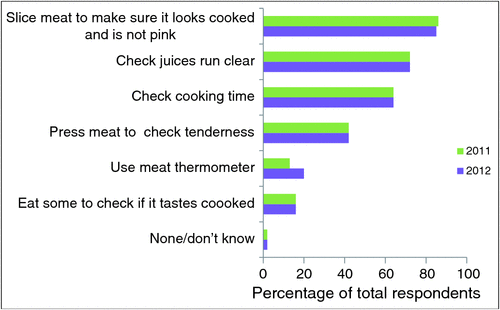Cooking meat at home
Patricia Desmarchelier and Juliana MaddenFood Safety Principles
558 Pullenvale Road, Pullenvale
Qld 4069, Australia
Tel: +61 7 3374 4530
Email: tdesmarchelier@bigpond.com
Microbiology Australia 34(2) 111-113 https://doi.org/10.1071/MA13038
Published: 13 May 2013
One of the five keys to safer food promoted by the World Health Organization for consumers is “cook thoroughly” as cooking food properly kills almost all dangerous microorganisms1. While this simple message is similarly promoted throughout Australia, beliefs and self-reported behaviours among consumers concerning cooking can vary. Here we describe consumer surveys on cooking meat as an example.
Preparing food at home remains a common practice for most Australians. In 2009, when 1,421 people were interviewed about the dinner meal they had the previous night, more than 7 out of 10 meals were prepared at home and common food items were vegetables (92%) and meats, including fish and poultry (90%; MLA, 2011)2. In Australia, between 2001 and 2009, 9.8% of 1,025 reported foodborne outbreaks were located in private residences3. There are multiple factors within and/or outside the home that could have contributed to these outbreaks although this information is limited. For the consumer and home food preparer, practising basic food safety measures will help to prevent foodborne illness and these include: Clean (wash hands, utensils and surfaces), Separate (prevent cross-contamination), Cook (cook to proper temperature), and Chill (refrigerate promptly to the right temperature)4.
The Food Safety Information Council (FSIC) is an independent, not-for-profit group supported by Federal, State and Local government agencies, professional, industry and community organisations, and individual members. It provides food safety information for Australian consumers through its online resources, media releases, television and radio community service announcements and Australian Food Safety Week. Each year after Food Safety Week the FSIC contracts a public opinion polling agency to conduct a nationwide survey of consumer knowledge and self-reported behaviours related to its key food safety messages. The survey is conducted by telephone among persons over 18 y (>1,000) selected by a random process including capital and non-capital cities and subdivisions, telephone numbers and household positions; return calls for those frequently away; and, to reflect population distributions results are post-weighted using Australian Bureau of Statistics data. Here, we present some results of FSIC surveys related to cooking, one of the key food safety measures, and cooking meat, one of the most common foods cooked.
Between 2002 and 2012, respondents have been asked which of a selection of meats and meat products must be cooked all the way through to avoid food poisoning. Respondents have consistently believed chicken (>97%) was most important followed by sausages (overall range 86–92%) and hamburgers (overall range 78–84%). The belief hamburgers should be thoroughly cooked had a downward trend to 79% in 2012 mainly among younger adults, males, university educated and highest income groups. This trend should be monitored as consuming hamburgers has been identified as a risk factor for Shiga toxin-producing Escherichia coli in Australia5. About a third of respondents believed beef steaks should be thoroughly cooked with a progressive and significant downward trend among females and 35–49 y olds (Figure 1). This practice is safe unless steaks are not intact through tenderising, or, if marinade is internalised during vacuum tumbling. Pork was included in 2011 with 85–86% believing this meat required thorough cooking, particularly older respondents, non-city dwellers, and households with children. This may reflect continuing misbeliefs about parasites present in pork (DAFF, 2004)6.

|
Rolled roast meats need to be thoroughly cooked to inactivate internalised vegetative cells and were included in 2011 and 2012. Responses were consistent, though varied, with meat species: 87–86% believed boneless rolled turkey and 44–43% believed boneless rolled lamb roasts needed to be cooked through; about half of respondents over 50 y believed the latter. Further investigation is required as consumers may differentiate cooking requirements based on the meat species, although they may not understand the requirements for different preparations e.g. when internalising surfaces and/or ingredients not directly exposed to heat.
The surest way to determine when meats reach safe cooking temperatures is using a thermometer7 (Figure 2). In 2011 and 2012, 23–25% respondents claimed to have a meat thermometer in their home. Ownership was negatively linked with low household income and those over 65 y. Of those owning a thermometer in 2012, 44%, 35% and 10% claimed to have used it ≤1, 2–12 and >12 months ago, respectively. Thermometer use has been actively promoted for domestic use more recently in Australia. In the United States of America thermometers have been promoted for longer and ownership was reported to have increased to 70% and linked with socio-economics7. In the USA self-reported usage varies with meats e.g. roasts, followed by chicken and hamburgers. Continuing promotion of usage and retail availability of appropriate thermometers should be encouraged.

|
Chicken dishes have been commonly attributed in foodborne illness outbreaks in Australia3. Thermometers are recommended to test that safe temperatures are reached during cooking. Ensuring the meat is not pink and the juices run clear has been widely recommended, although this is not always a reliable indicator of reaching safe temperatures or “doneness”. Pink colour can be due to characteristics of the bird, storage conditions, ingredients or marinades. Respondents were surveyed from 2011 on how they check if poultry is cooked and safe to eat (Figure 3). Most respondents, both years, claimed to test for colour change in flesh (85%) and juices (72%) and 62% used both; a lesser number used cooking time (64%) and tenderness (42%). Of concern is the 16%, mainly males, and lower income and education level groups, who “eat some to see if it tastes cooked”. These results flag an ongoing need to inform consumers on the hazards of consuming undercooked chicken and safe cooking practices. On the other hand, the use of a meat thermometer increased from 13% to 20% indicating a promising increased awareness of this more safe method.

|
The results presented are beliefs and self-reported behaviours that have not been validated by observations. However, the value of these results is a consistent methodology, following food safety campaigns over 10 years, providing trends linked with demographic data. Just one of the surveyed issues is presented here to illustrate how food safety messages are perceived and practiced, and this could guide consumer information messages.
Acknowledgements
The FSIC acknowledges Newspoll who helped design and conduct the surveys and all previous FISC Executive members who initiated and have sustained the activity. Also acknowledged are the Australian Government Department of Health and Ageing, the major sponsor, and other Australian, State and Territory Government Agencies, commercial enterprises, Professional Associations, Local Government and individual members who support the FSIC.
References
[1] WHO (2012) Five keys to safer food. http://www.who.int/foodsafety/publications/consumer/en/5keys_en.pdf) (accessed 18 December 2012).[2] MLA (2011) Last night’s dinner. http://www.mla.com.au/Marketing-red-meat/Domestic-marketing/Market-research (accessed 10 December 2012).
[3] Astridge, K. et al. (2011) Foodborne disease outbreaks in Australia 2001–2009 Food Aust. 63, 44–50.
[4] FSIC (Food Safety Information Council) (2012) How you cook can make you crook. http://www.foodsafety.asn.au/_srcfiles/NewcrookPoster_A2.pdf (accessed 9 December 2012).
[5] McPherson, M. et al. (2009) Serogroup-specific risk factors for Shiga toxin-producing Escherichia coli infection in Australia. Clin. Infect. Dis. 49, 249–256.
| Serogroup-specific risk factors for Shiga toxin-producing Escherichia coli infection in Australia.Crossref | GoogleScholarGoogle Scholar | 19522658PubMed |
[6] DAFF (Australian Government Department of Agriculture, Fisheries and Forestry) (2004) Generic Import Risk Analysis (IRA) for pig meat – final import risk analysis report.
[7] Lando, A.M. and Chen, C.C. (2012) Trends in ownership and usage of food thermometers in the United States, 1998 through 2010. J. Food Prot. 75, 556–562.
| Trends in ownership and usage of food thermometers in the United States, 1998 through 2010.Crossref | GoogleScholarGoogle Scholar | 22410231PubMed |
Biographies
Dr Trish Desmarchelier is a consultant in food safety specialising in bacterial foodborne pathogens and food safety risk management. She is the current Convenor of the Food Safety Information Council’s Technical Group.
Ms Juliana Madden is a science communications consultant specialising in food issues. She has been the Executive Officer of the Food Safety Information Council since 2007.


